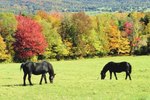As long as livestock remains an integral part of agricultural society, there will always be the demand for animal feed on a large scale. With a large variety of livestock, from cows to chickens to horses to ducks, there must also be a large variety of different feed to accommodate their individual needs.
Basics
The commercial sale and industrial production of animal feeds has a history dating back as far as the 1800s. It was during this time period that the significance of balanced diets and nutrients in the diets of humans and animals was beginning to make steam as a mainstream ideology. One of the first big feed producers, which was the first to manufacture corn gluten feed, was called Purina and was established in 1882. It expanded its operations near the beginning of the 20th century and still operates today. In modern times, there are three major types of feed used by farmers, each with their own uses and benefits.
Compound Feed
One of the most common types of feeds used by commercial farmers is compound feed. Also known as feedstuffs, they’re blends of various additives and raw materials that are formulated to specifically suit the intended animal. They’re often produced as pellets or crumbles. Like modern vitamins with humans, they can be used to either satisfy the complete nutritional requirements of their target animals or as a supplement to other staples of the animals’ diets. They’re often complemented with extra vitamins and minerals. It is produced in astronomically large amounts, with over 600 million tons produced annually on a global scale.
Fodder
Fodder, another type of animal feed, is used primarily to feed domesticated livestock such as goats, sheep, cattle, horses and pigs. It is typically composed of plant matter like hay, straw and grains. The term is used to describe these plants being given to the animals after the plants have been harvested, which contrasts with forage, as will be explained below. Meat and bone meal are occasionally mixed into fodder, which has been frequently blamed for the spread of mad cow disease and has been banned in many countries.
Forage
Unlike fodder, which is harvested plant matter fed to animals in bunches or bales, forage is plant matter that is literally grown in a confined area with the intention of having it grazed upon by various livestock. It can be composed of legumes, grasses, corn, oats, alfalfa and other edible plants. The act of eating or grazing upon the plant matter is known as foraging.
Revenue
The feed industry is a major economical component of many countries. According to the AFIA (American Feed Industry Association), an average of $20 billion is annually spent on feed ingredients. The feed industry is also the largest purchaser of corn and soybean meal.
References
Writer Bio
Brenton Shields began writing professionally in 2009. His work includes film reviews that appear for the online magazine Los Angeles Chronicle. He received a Bachelor of Science in social science and history from Radford University.




